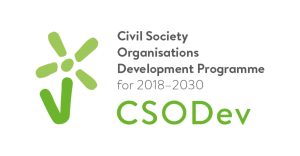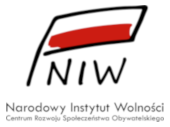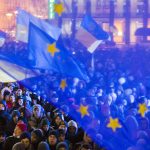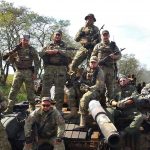SPECIAL REPORTS
Date: 20 September 2019 Author: Grzegorz Kuczyński
Russia-Ukraine Prisoner Exchange: Zelensky Caught Into Russian Trap
An actual prisoner swap between Ukraine and Russia is a PR success of Ukraine’s incumbent leader Volodymyr Zelensky, yet it is his Russian counterpart who won politically. The negotiating process of the prisoner exchange, how it was performed and the names of those who were meant to be freed eventually shed a negative spotlight on Ukraine.
- The Kremlin de facto blackmails Zelensky who made a tremendous mistake when announcing his bid to quit the ongoing Ukrainian-Russian war by the end of this year. Ukraine’s leader therefore has fallen victim to the promises he had made and massive social expectations that followed suit. Portraying the prisoner swap as a prelude to further decisions to be taken to bring peace back to Ukraine’s Donbas will mean Russia’s pursuit for dictating a high price for such a scenario to take place.
- With the September 7 exchange Moscow has to a great extent narrowed down negative consequences of two legal cases currently pending outside Russia and Ukraine, which are the ruling of the International Tribunal for the Law of the Sea of May 25, 2019, ordering Russia to release Ukrainian seamen taken captive back in November 2018 and the probe into the downing of the Malaysia Airlines flight MH17.
- While giving his go-ahead for the prisoner exchange, Putin sought to demonstrate his alleged readiness to make concessions in a move being to the liking to the countries of the West, with Germany and France at the helm. It is to be expected that both Berlin and Paris, especially the latter, will push Zelensky for making further concessions to Moscow. This, if combined altogether, makes the Ukrainian leader face a tough choice, drifting him either towards peace solutions at all costs (thus surrender), or a toughened stance on Russia, which is de facto a comeback to the policy adopted back then by his predecessors.
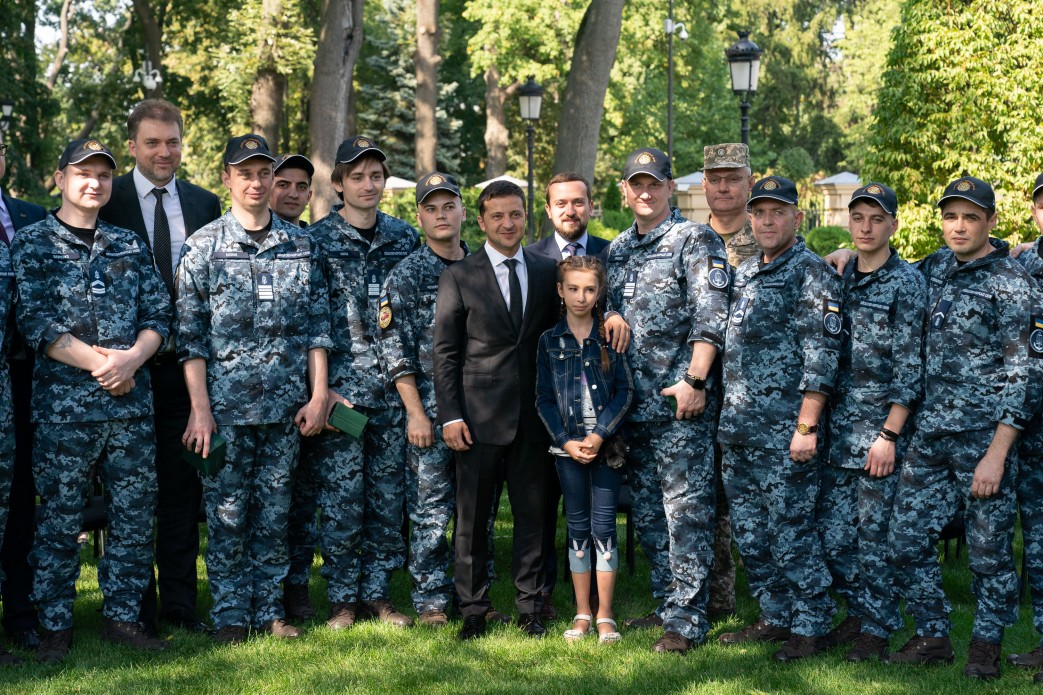 Ukrainian President Volodymyr Zelensky and the seamen released by Russia. Source: PRESIDENT.GOV.UA
Ukrainian President Volodymyr Zelensky and the seamen released by Russia. Source: PRESIDENT.GOV.UAUkraine and Russia failed to complete their long-awaited prisoner swap on September 7. As earlier formally agreed upon, both sides committed themselves to take part in a 35-for-35 prisoner swap, with the list of captives submitted by the other party. Releasing Ukrainian citizens held in custody, either in Russia or in the occupied region of Donbas, has become one of Zelensky’s top priorities since he came to power. Direct albeit secret talks were being held since August 7, 2019, at the initiative of the Ukrainian leader, and it all began with fighting running high in Donbas. August has seen one of the bloodiest battles taking place in Donbas for many years since then, with Russia making efforts to force Zelensky to bow to pressure, act faster and, all in all, make further concessions. A deadly shelling killed four Ukrainian soldiers in the night from August 6 to August 7. This struck a massive blow into Zelensky’s image as a leader who kept promising to bring peace back to Donbas since he took the oath of office. So he did precisely what Russia hoped for. “The administration of Ukraine’s President Vladimir Zelensky has demonstrated a sensible approach and readiness for compromises, unlike his predecessors,” Russia’s Foreign Ministry said in a statement commenting on the Moscow-Kiev prisoner swap. Here “compromises” mean “concessions.” On August 7, Volodymyr Zelensky called Russian leader Vladimir Putin on the phone asking him to influence the other side so that they stopped fighting in Donbas. And this fact alone was received by the Kremlin as a double victory. First, while making such a request, Zelensky saw Russia not as a party to the conflict, but as a mediator in the ongoing bloody clash. Secondly, the Ukrainian leader derailed dialogue mechanisms with Russia that so far had functioned under the umbrella of both Germany and France. When giving his nod to hold bilateral negotiations on freeing prisoners in secrecy, Zelensky ignored the fact that this issue should be handled by one of the working groups within the framework of the Minsk Contact Group, as was stipulated by the Minsk agreements.
Launched in the wake of Zelensky-Putin phone call of August 7, Moscow-Kiev negotiations were lengthy and complicated. Moscow at least once lured its Ukrainian partners into a PR trap; owing to a well-though disinformation game, the same day when Ukraine’s new parliament was sworn in, the Ukrainian authorities, including the country’s prosecutor general, announced that a plane carrying freed Ukrainian prisoners was en route to Kiev. That turned out to be fake news but eventually put Zelensky under mounting pressure to allow the swap to take place. On September 7, Kiev and Moscow announced a jointly agreed decision to release 35 prisoners each. The exchange took place later that day. Earlier, it was reported that Russian President Vladimir Putin pardoned 11 Ukrainian political prisoners and, in turn, President of Ukraine Volodymyr Zelensky pardoned 16 people. 24 Ukrainian sailors taken captive in November in the aftermath of a Kerch Strait incident were released under a bail scheme against guarantees of Lyudmila Denisova, a human rights ombudswoman of Ukraine’s Verkhovna Rada, while Ukrainian courts freed 19 people under their personal commitments. Both how the swap took place and those among the enlisted people immediately sparked off a wave of controversy.
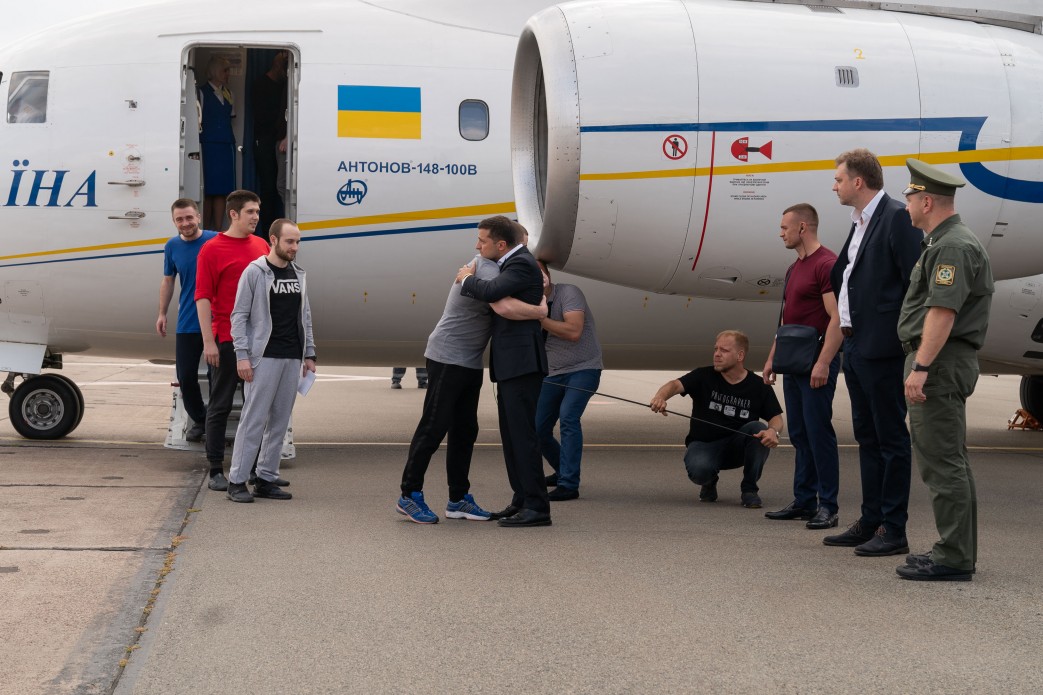 Ukrainian President Volodymyr Zelensky welcomes recently exchanged Ukrainian prisoners upon arrival from Moscow.
Ukrainian President Volodymyr Zelensky welcomes recently exchanged Ukrainian prisoners upon arrival from Moscow.Source: PRESIDENT.GOV.UA
While the Russian side returned mostly the hostages earlier taken captive among innocent Ukrainian people, all those released by Ukraine fought in the hybrid war Russia has been waging against Kiev. Included in the group were soldiers, members of paramilitary units, intelligence agents, public agitators, or even terrorists, among whom a woman who plotted the assassination of an SBU officer in Mariupol. These are chiefly Ukrainian citizens. Under the Constitution of Ukraine, a citizen of Ukraine may not be expelled from Ukraine or surrendered to another state. To ensure full compliance with provisions of the law, prisoners transferred to Russia should have been granted Russian citizenship. What is known is that several members of the group did not fly to Russia immediately after being freed. But there is more to that. A full list of people freed by Russia and Ukraine was not posted immediately while the details of the negotiations were kept in secret. Critics say that Zelensky did his utmost to release Ukrainian filmmaker Oleg Sentsov and sailors merely to show his compatriots the ability to achieve quite quickly something Petro Poroshenko had failed.
Support Us
If content prepared by Warsaw Institute team is useful for you, please support our actions. Donations from private persons are necessary for the continuation of our mission.
Tsemakh and the sailors
What was referred to as a gross violation of legal provisions at the cost of a short-term political goal was releasing by Ukraine a critical person in the court case into the 2014 downing of Malaysia Airlines flight MH17 over eastern Ukraine. Had Zelensky failed to do so, there would have been no prisoner swap at all. Freeing Vladimir Tsemakh was a fundamental prerequisite for Moscow, without which it would have rebuffed any agreement with Ukraine. Tsemakh has unique knowledge of the shooting down of Malaysia Airlines flight MH17 that killed 298 people on board, mostly Dutch nationals. The missile was fired from rebel-held areas, from a launcher that belonged to a regular Russian missile unit. Tsemakh served as an “air defense coordinator” near the site of that catastrophe. He had helped escort the Russian Buk mobile air-defense battery that shot down the MH17 airliner. In June 2019 Ukraine’s military Spetsnaz forces carried out a reckless raid in an effort to abduct Tsemakh from the Russian-occupied region of Donbas. As a result, an experienced intelligence officer was killed while one of the wounded men lost a leg. Ukraine’s prosecutor’s office formally charged Tsemakh with participating in a terrorist organization. The Netherlands called Tsemakh a suspect in the downing of the MH17 passenger jet, Dutch prosecutor informed Ukraine’s prosecutor’s office on August 30.
Initially no one had seen Tsemakh among those to be released in the Moscow-Kiev swap. It was not until the end of August that Russia was reported to have insisted on the release of Tsemakh as a condition for the prisoner exchange. Unofficial reports have confirmed Kiev’s consent, and this triggered off a sharp reaction from the Netherlands. Sometime later, on September 4, a group of 40 members of the European Parliament called on Zelensky not to send Tsemakh back to Russia. But in vain. To release Tsemakh, the Ukrainian authorities were in breach of legal procedures. On August 22, the Shevchenko District Court of Kiev ruled to keep the rebel fighter in detention until October 20, and Tsemakh’s defenders should have appealed against the decision before August 28 at the latest. Instead, they filed an appeal on September 3, which theoretically should make the request null and void in the light of the law. And yet, two days later, on September 5, Kiev’s Court of Appeal ruled to free Tsemakh on personal recognizance. Under the court ruling, he is supposed to report his address and work place to the authorities and to remain at their disposal for two months. What deemed a success for the previous administration was capturing Tsemakh though coming at high costs. In an international court case over the downing of MH17 Tsemakh might have been used to both prosecute and perhaps also to serve as a proof of Russia’s guilt. But the Zelensky administration has decided to forfeit this chance while jeopardizing its relationship with the West, mostly with the Netherlands. By giving Tsemakh back to Russia, Kiev’s presidential center has missed an opportunity to play up the international court case over MH17 against Russia. Releasing the rebel fighter will affect the behavior of other Moscow captives who may refuse to testify in front of the court, seeing a chance for them to be delivered on Russian soil. On the same day coinciding with Tsemakh’s abduction, the court released from custody Oleksandr Rakushin, a former Ukrainian military officer with the alleged FSB history record.
The 35 freed citizens of Ukraine who returned home include the 22 sailors and 2 SBU officers detained near the Kerch Strait in November 2018. Russia was legally obliged to unconditionally release those sailors under the May 25, 2019, verdict by the International Tribunal for the Law of the Sea. However, Moscow failed to stick to its commitments, choosing instead to free the seamen as part of a bilateral deal with Ukraine. While rebuffing the Tribunal’s ruling, Moscow showed that it does not recognize any international jurisdiction in its “territorial waters” off the Kerch Strait, unilaterally redefined after seizing Crimea from Ukraine. The Zelensky administration has buried two key achievements of its predecessors in the fight against Russian aggression. What has been accomplished is of great importance worldwide: the previous administration of Petro Poroshenko had achieved that victory in the International Tribunal, bringing Russia legally obliged to free the seamen. The Zelensky administration, in its turn, sent these sailors regardless of the tribunal’s ruling, thus indirectly corroborating Russia’s stance on the Kerch Strait. Ukraine’s incumbent authorities have missed the opportunity to take advantage of the verdict, eyed by Moscow as unfavorable.
Releasing 35 Ukrainian citizens, of whom the detained seamen, from Russia’s hands will make Zelensky score some points in Ukrainian society. The problem is, however, that freeing Tsemakh may negatively affect Kiev’s ties with the West. Once accomplished, this will nurture further arguments of those being in favor of relaxing international sanctions against Russia while undermining Ukraine’s position on a peaceful settlement of the Donbas conflict. And this will empower Moscow to accuse Kiev of obstructing the ongoing probe into the MH17 downing. And, of course, if Tsemakh disappears, the Russian authorities will state he does not hold Russian citizenship and they do not know where he is. Under the court’s ruling, he might have traveled to his hometown of Snizhne but is forced to report his address and work to the authorities. Snizhne is part of the Russia-occupied area so the Court of Appeal, when being politically motivated, released Tsemakh onto the territory that de facto remains within Moscow’s governance.
Hostages and mediators
Moscow has the right to believe that it will be capable of freeing a larger group of agents out of the Ukrainian custody. On September 13, Kremlin spokesman Dmitry Peskov said Moscow is not ruling out a new prisoner swap with Ukraine. Peskov’s statement came just hours after Volodymyr Zelensky noted at the opening of the annual Yalta European Strategy (YES) meeting in Kiev that his government is working to prepare a new list of Ukrainian citizens held in Russia for a possible swap. The following day, 54 people were returned to Ukraine from the so-called Luhansk People’s Republic. They were serving a sentence for committing common crimes in the penitentiary facilities in the occupied part of the Luhansk region. The number of “SBU spies” held in custody in Donbas grew practically throughout August. Some convicts were serving punishments of at least 12 years in prison. On September 9, a resident of the Russia-occupied town of Horlivka in eastern Ukraine was sentenced to 15 years in a maximum-security penal colony for “espionage.”
As announced on September 5, another resident of the “Donetsk People’s Republic” was pronounced guilty for espionage to serve 17 years in prison. Though both sentences were handed over in early August, they have not been made public until recently. Hundreds of Ukrainian nationals that are being kept in custody, both in Russia and the Russia-occupied Donbas, officially have the status of “detained persons.” According to the Ukrainian parliament’s human rights ombudsman, Ludmila Denisova, Ukraine has specifically identified 113 of its citizens detained in Russia as a consequence of this war, but the actual number is almost certainly higher. Added to this are also prisoners held in detention by security services of the “people’s republics” in Donbas. Ukraine’s SBU so far has identified personal details of 227 such people. Most of those held in Ukraine are apparently fewer and they served Russia in this undeclared war.
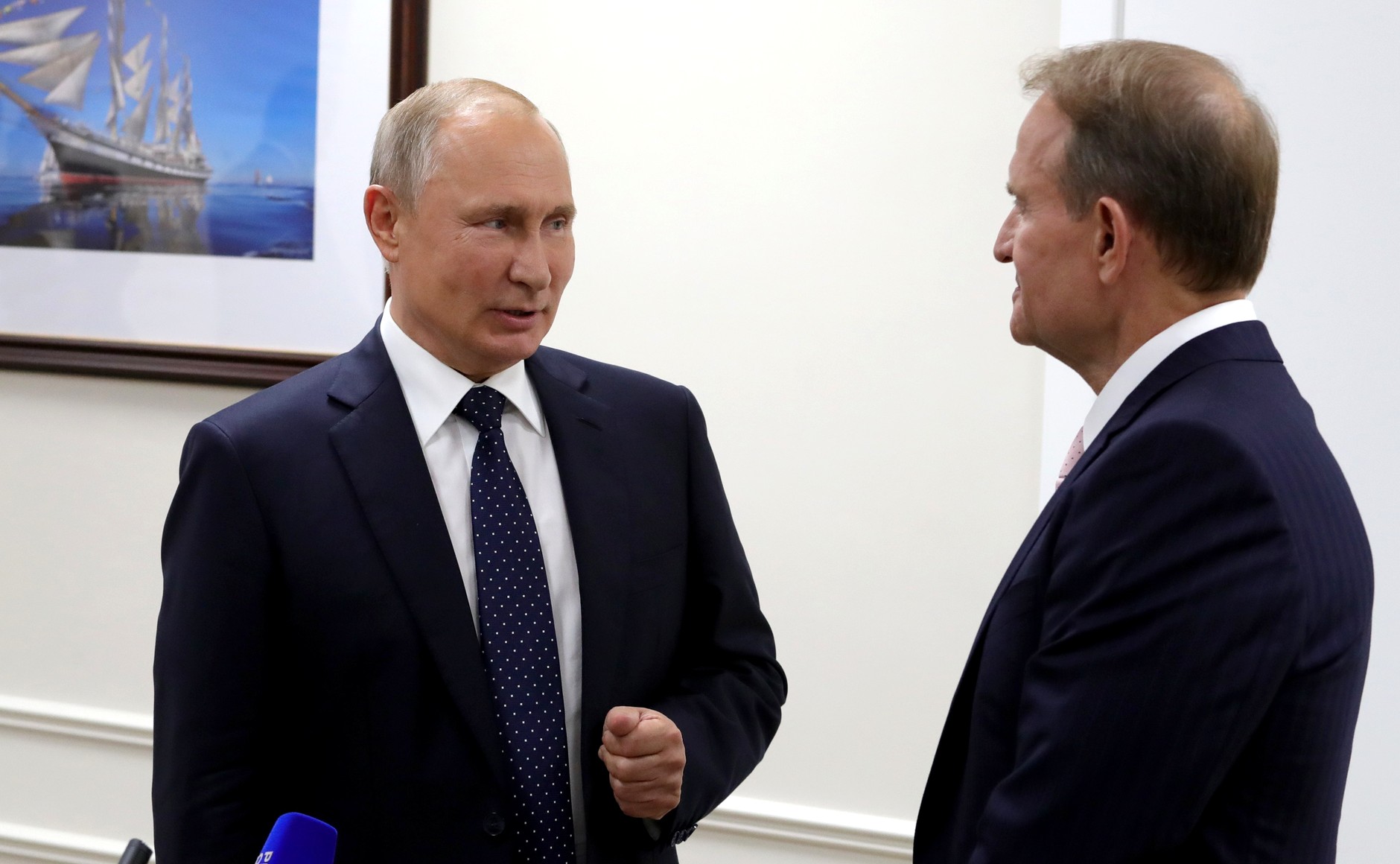 Russian President Vladimir Putin holds a meeting with Viktor Medvedchuk. Source: KREMLIN.RU
Russian President Vladimir Putin holds a meeting with Viktor Medvedchuk. Source: KREMLIN.RUThe Minsk “accords” call for the exchange of detained persons. President Petro Poroshenko’s administration (2014–2019) succeeded in releasing almost 3,000 Ukrainian citizens from Russian or rebel captivity. Poroshenko accepted the political risk of empowering his adversary, the Kremlin’s ally Viktor Medvedchuk, to negotiate those exchanges. The Kremlin allowed him to bring prisoners home to Ukraine, expecting thereby to boost Medvedchuk’s and his party’s political rating in Ukraine. The last such exchange took place in December 2017, after which Poroshenko ended Medvedchuk’s mediating role. Medvedchuk is no longer needed to fulfill his purpose, at least for now, also by the Kremlin, because Putin and Zelensky established a direct channel between their offices for handling mutual prisoner releases. As a former head of Leonid Kuchma’s presidential office who is now among top pro-Russian politicians in Ukraine, Medvedchuk may soon be back in the game, and even using this possibility for scaremongering may bring tangible results. While Kiev gave its red light to releasing Tsemakh, Vladimir Putin, speaking to an international forum in Vladivostok, just stated: “We are about to finalize the talks about the prisoners’ exchange, including the talks that we [also] conduct with the official authorities… I know that Mr. Medvedchuk feels very strongly about some of the Ukrainian detainees in Russia.” As Putin spoke, Russian television showed Medvedchuk sitting in the audience. The threat of raising Medvedchuk’s profile back to the prisoner swap talks, seen as a critical PR move, immediately spoke to Zelensky, and Putin only waited for that. On that same day, the Kiev appeals court freed Tsemakh. Not incidentally, an ex-SBU chief Valeriy Khoroshkovsky has assumed a post in Zelensky’s presidential office, since recently tasked with building Kiev’s economic and political ties with Moscow, albeit with no need to fall back on Medvedchuk’s mediation. Khoroshkovsky and Zelensky have known each other for 14 years and remained in close cooperation while the former owned a TV channel while the former was a TV comedian and producer. Khoroshkovsky owns a 45 percent stake in Inter TV, compared to 36 percent share held by Dmytro Firtash, 9 percent stake in possession of Serhiy Lovochkin, and 10 percent share owned by Svitlana Pluzhnikova. Admittedly, those behind Khoroshkovsky’s new political missions were Ukrainian businessmen Ihor Kolomoisky and Viktor Pinchuk, both of whom compete with Medvedchuk.
NEWSLETTER
Setting a trap for Zelensky
Zelensky and Russian President Vladimir Putin held a phone conversation after a prisoner swap in the 35-for-35 format on September 7. The statement released later by Zelensky’s presidential office read that a next prisoner swap was being discussed and that name of the Normandy summit will be named soon. But the Kremlin’s version is different. According to its official readout, they only “exchanged views about that possibility,” and Putin underlined the need for preparations to ensure results. Thus, Moscow skilfully plays up Zelensky’s display of impatience and eagerness. Ukraine’s incumbent leader seeks the further step to take place, seeing the 35-for-35 exchange format as a prelude to bringing back peace to the war-torn region of Donbas. While saying so, he meant the Normandy Four summit, a body that last met back in 2016. Zelensky said on September 12 that Ukraine is drawing out a roadmap for the implementation of the Minsk agreements, with clear deadlines. At the Normandy Four summit, Zelensky stated, “the Steinmeier Formula,” altogether with all points of the Minsk agreements, will be discussed, and decisions will be made by the leaders of the four countries.” Already at a September 2 meeting of foreign policy advisors of leaders of the Normandy Four countries in Berlin, Putin’s aide Vladislav Surkov spoke about the Steinmeier Formula. This plan provides for the simultaneous adoption of constitutional amendments to grant a special status to Donbas while holding local elections at once. The next step would be to pull out Russian troops and military hardware out of Donbas. A Kremlin aide, Yuri Ushakov, referred to the issue, saying that putting into action the plan authored by Steinmeier, Germany’s former foreign minister and incumbent president, is one of the three preconditions for the Kremlin’s acceptance for hosting a meeting within the framework of the Normandy Four. As for two other conditions to be fulfilled, Putin’s foreign policy advisor named the withdrawal of all troops and military equipment from the line of demarcation in three pilotage security areas, and the urge for drafting an agreement on the conclusions made at the meeting before the summit is held.
Under the Steinmeier plan, it is that on the day of elections, the special status for the occupied territories of Donbas takes provisional effect and it is set to become permanent once those elections are certified to be free and fair by the OSCE. Indeed, Ukrainian Foreign Minister Vadim Pristaiko said on September 14 that Kiev would not amend the country’s constitution to include the provisions on enacting a special status for rebel-held Donbas, but what he said about the country’s decentralization suggested the very same thing. There is no use amending the Ukrainian constitution to make Donbas a highly independent region – free from Moscow’s dependence and under Kiev’s formal authority. What still enshrines as a moot point is the order of implementing individual provisions of the Minsk agreements. Russia refuses to take first steps in pulling out its servicemen from Donbas in a bid to allow Ukraine to restore control of this section of the Ukraine-Russia border. Among the essential prerequisites for Russia’s go-ahead for a meeting of the Normandy Format was to guarantee that the Ukrainian army will under any circumstances refrain from responding to enemy shelling. Under this unilateral ceasefire, on September 11, three volunteer battalions that for years fought for Kiev handed over their weapons. And despite this, Russians and secessionist fighters continue to shell Ukrainian positions. In August, events unfolded in a tragic way, resulting every week in a dramatic loss of lives and many injured. In the first week of September, before the September 7 prisoner swap, four Ukrainian troops were deadly wounded on the line of front.
So far Kiev has rebuffed to implement the Minsk political provisions in line with the so-called Steinmeier formula. They stipulate for the simultaneous adoption of amendments to the Constitution by Ukraine’s Verkhovna Rada that enacts a special status for Donbas while staging local elections in the area, in the wake of which Russia would be legally obliged to withdraw its troops and military hardware from the region. Zelensky’s Servant of the People Party won 254 seats in the new parliament, but to approve constitutional amendments, a 300-vote majority is required. Zelensky can secure such a smashing majority only if backed by other parliamentary groups and non-factional deputies. But voting on the special status of Donbas may be a perilous move, as exemplified by an August 31, 2015, attempt. This sparked a public outcry in front of the Ukrainian parliament building. Four members of the Ukrainian national guard were killed in a grenade blast. The Zelensky administration is likely to push forward a new model for a peaceful resolution of the conflict, a plan intended to sweep away the Minsk agreements, and more precisely the Minsk II peace deal. Ukrainian tycoon Ihor Kolomoisky has already submitted his Donbas peace scenario. Under his plan, among the mechanisms for settling the conflict is a ceasefire and an exchange of prisoners, followed by local elections held in the light of Ukrainian law and under the control of the Ukrainian authorities. As he later said, the day after the elections, the process of transferring control over the border would be set to begin. These efforts will be culminated by adopting legislation on a special status of Donbas, albeit with no need to amend the Constitution. This would be a solution foreseen to last for no longer than five years.
Perhaps if the leaders of Russia Ukraine, France, and Germany meet at a Normandy Format summit, they will not necessarily come to any groundbreaking conclusions. And above all, the Kremlin is not in a hurry to push ahead with these decisions. Unlike his Russian counterpart, Zelensky has staked his popularity ratings on ending the war in Donbas by the end of this year. What may be an outcome of a Normandy Four summit, if such eventually takes place, could be Putin’s and Zelensky’s official go-ahead for direct talks. Perhaps the Kremlin will also urge Kiev to forge a dialogue with the leaders of the so-called people’s republics. The latter solution would, however, entail a risk for the Ukrainian leader, because society will understand his negotiations with Putin, but not those held with separatist rebels.
Author:
Grzegorz Kuczyński – Director of Warsaw Institute Eurasia Program.
He graduated in history at the University of Bialystok and specialized Eastern studies at the University of Warsaw. He is an expert on eastern affairs. He worked as a journalist and analyst for many years. He is the author of many books and publications on the inside scoop of Russian politics.
The publication of the Special Report was co-financed from the funds of the Civic Initiatives Fund Program 2018.
The concept of analytical material was created thanks to co-financing from the Civil Society Organisations Development Programme 2019.
Selected activities of our institution are supported in cooperation with The National Freedom Institute – Centre for Civil Society Development.
All texts published by the Warsaw Institute Foundation may be disseminated on the condition that their origin is credited. Images may not be used without permission.


